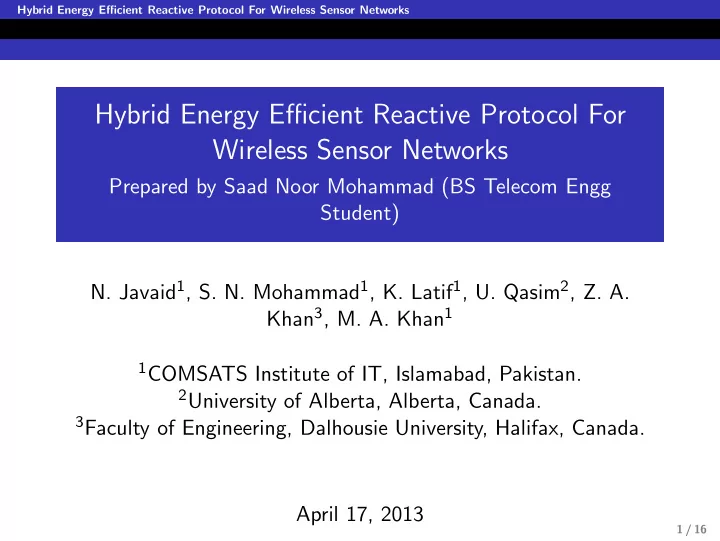

Hybrid Energy Efficient Reactive Protocol For Wireless Sensor Networks Hybrid Energy Efficient Reactive Protocol For Wireless Sensor Networks Prepared by Saad Noor Mohammad (BS Telecom Engg Student) N. Javaid 1 , S. N. Mohammad 1 , K. Latif 1 , U. Qasim 2 , Z. A. Khan 3 , M. A. Khan 1 1 COMSATS Institute of IT, Islamabad, Pakistan. 2 University of Alberta, Alberta, Canada. 3 Faculty of Engineering, Dalhousie University, Halifax, Canada. April 17, 2013 1 / 16
Hybrid Energy Efficient Reactive Protocol For Wireless Sensor Networks Motivation Most routing protocols are for proactive networks DEEC is for proactive networks and TEEN is for reactive networks. HEER is for reactive networks HEER outperforms both DEEC and TEEN in homogeneous and in heterogeneous environment. 2 / 16
Hybrid Energy Efficient Reactive Protocol For Wireless Sensor Networks HEER Idea Figure Normal nodes High energy nodes Cluster head Transmitting data Base station If CV>=HT State(2) State(1) Let Cv=SV Data transmission Data transmission If CV-SV>=ST State(4) State(3) 3 / 16
Hybrid Energy Efficient Reactive Protocol For Wireless Sensor Networks HEER Protocol Nodes become CHs due to residual energy We introduced thresholds(hard and soft) P i = P opt E i ( r ) / (1 + am )¯ Er (1) CV − SV ≥ ST (2) 4 / 16
Hybrid Energy Efficient Reactive Protocol For Wireless Sensor Networks Parameters Parameters Values Initial energy, E 0 0.5 J Transmitting and Receiving energy, E elect 5nJ/bit Amplification energy for short distance, E fs 10pJ/bit/m2 Amplification energy for long distance, E mp 0.013 pJ/bit/m2 Energy for data aggregation, E DA 5nj/bit/signal Percentage of advanced nodes, m 0.1 Energy of advance nodes E 0 (1+a) Table : Parameters used in our simulations 5 / 16
Hybrid Energy Efficient Reactive Protocol For Wireless Sensor Networks Parameters Protocol Stability period Life time Environment Classification Teen 1221 1947 Homogeneous Reactive DEEC 1395 2461 Homogeneous Proactive hard HEER 2005 3595 Homogeneous Reactive soft HEER 2493 3959 Homogeneous Reactive Table : Comparison table: when HT=100 and ST=2 6 / 16
Hybrid Energy Efficient Reactive Protocol For Wireless Sensor Networks Simulations 100 TEEN DEEC 90 hard HEER soft HEER 80 70 60 Alive nodes 50 40 30 20 10 0 0 500 1000 1500 2000 2500 3000 3500 4000 4500 No of rounds Figure : Homogeneous environment HT=100,ST=2 7 / 16
Hybrid Energy Efficient Reactive Protocol For Wireless Sensor Networks Simulations Stability period of HEER is much longer than that of DEEC and TEEN CH selection in HEER is due to residual energy and moreover, hard and soft threshold are also introduced which increases the stability period and network lifetime We observe that in TEEN after the death of first node, all the remaining nodes die within a small number of rounds. This is due to the reason that all the nodes have same probability to become a CH CH selection in DEEC is due to residual energy only 8 / 16
Hybrid Energy Efficient Reactive Protocol For Wireless Sensor Networks Simulations 5 x 10 2.5 2 1.5 TEEN Packets to BS DEEC hard HEER soft HEER 1 0.5 0 0 500 1000 1500 2000 2500 3000 3500 4000 4500 No of rounds Figure : Homogeneous environment HT=100,ST=2 9 / 16
Hybrid Energy Efficient Reactive Protocol For Wireless Sensor Networks Simulations Number of transmissions to BS are limited by hard threshold Number of transmissions to BS are further scrutinized by soft threshold which reduces energy consumption From previous slide we can observe that by increasing difference between threshold we are increasing packets to BS 10 / 16
Hybrid Energy Efficient Reactive Protocol For Wireless Sensor Networks Simulations 100 TEEN DEEC 90 hard HEER soft HEER 80 70 60 Alive nodes 50 40 30 20 10 0 0 500 1000 1500 2000 2500 3000 3500 4000 4500 No of rounds Figure : Homogeneous environment HT=70,ST=10 11 / 16
Hybrid Energy Efficient Reactive Protocol For Wireless Sensor Networks Simulations By reducing the difference between thresholds we can vary our stability period and network lifetime as per our application By increasing the difference between the thresholds we can increase our stability period and network lifetime In the previous slide we observe, that my reducing the difference between thresholds we are actually reducing our stability period and network lifetime 12 / 16
Hybrid Energy Efficient Reactive Protocol For Wireless Sensor Networks Simulations 5 x 10 2 1.8 1.6 TEEN 1.4 DEEC hard HEER 1.2 Packets to BS soft HEER 1 0.8 0.6 0.4 0.2 0 0 500 1000 1500 2000 2500 3000 3500 4000 4500 No of rounds Figure : Homogeneous environment HT=70,ST=10 13 / 16
Hybrid Energy Efficient Reactive Protocol For Wireless Sensor Networks Simulations By reducing the difference between thresholds we can vary packets sent to BS which is set accordingly as per our application By reducing difference between thresholds we reduce our packets to BS By lowering difference in thresholds we reduce energy consumption 14 / 16
Hybrid Energy Efficient Reactive Protocol For Wireless Sensor Networks Conclusion HEER minimizes energy consumption by distributing load to all high energy nodes and then on to low energy nodes HEER is well suited for well suited for time critical applications HEER outperforms DEEC and TEEN in homogeneous environment HEER outperforms DEEC in terms of stability period and network lifetime by a factor of 1.78 and 1.60 respectively Relative to TEEN, HEER outperforms it in terms of stability period and network lifetime by a factor of 2.0 15 / 16
Hybrid Energy Efficient Reactive Protocol For Wireless Sensor Networks Questions Questions Thank you! 16 / 16
Recommend
More recommend